Reading: Meiosis
http://www.ck12.org/saythanks
• Describe asexual reproduction; explain the genetic relationship between parent and offspring.
• Describe sexual reproduction; explain the genetic relationship between parent and offspring.
• Identify and describe the main steps of meiosis, distinguishing between the quantity of genetic material in the parent and resulting cells.
• Describe gametogenesis and identify the key differences between oogenesis and spermatogenesis.
• Distinguish between the three types of sexual life cycles.
Introduction
Some organisms look and act exactly like their parent. Others share many similar traits, but they are definitely unique individuals. Some species have two parents, whereas others have just one. How an organism reproduces determines the amount of similarity the organism will have to its parent. Asexual reproduction produces an identical individual, whereas sexual reproduction produces a similar, but unique, individual. In sexual reproduction, meiosis produces haploid gametes that fuse during fertilization to produce a diploid zygote ( Figure 1.1 and Figure 1.3).
Asexual Reproduction
Are there male and female bacteria? How could you tell? Remember, bacteria have just one chromosome; they do not have an X or Y chromosome. So they probably have a very simplified form of reproduction. Asexual reproduction, the simplest and most primitive method of reproduction, produces a clone, an organism that is genetically identical to its parent. Haploid gametes are not involved in asexual reproduction. A parent passes all of its genetic material to the next generation. All prokaryotic and many eukaryotic organisms reproduce asexually.
There are a number of types of asexual reproduction including fission, fragmentation and budding. In fission, a parent separates into two or more individuals of about equal size. In fragmentation, the body breaks into several fragments, which later develop into complete adults. In budding, new individuals split off from existing ones. The bud may stay attached or break free from the parent. Eukaryotic organisms, such as the single cell yeast and multicellular hydra, undergo budding ( Figure 1.2).
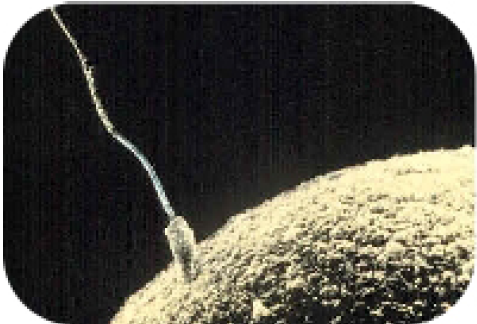
FIGURE 1.1
Fertilization of an egg cell by a sperm cell. In sexual reproduction, haploid gametes fuse to produce a diploid zygote.
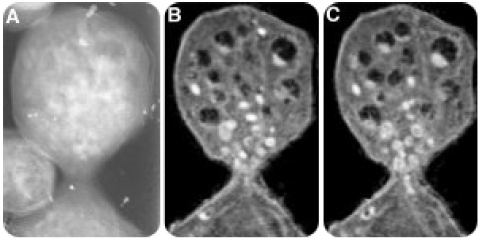
FIGURE 1.2
Magnification of a budding yeast.
Sexual Reproduction and Meiosis
Why do you look similar to your parents, but not identical? First, it is because you have two parents. Second, it is because of sexual reproduction.
Whereas asexual reproduction produces genetically identical clones, sexual reproduction produces genetically diverse individuals. As both parents contribute half of the new organism’s genetic material, the offspring will have traits of both parents, but will not be exactly like either parent.
Organisms that reproduce sexually by joining gametes, a process known as fertilization, must have a mechanism to produce haploid gametes. This mechanism is meiosis, a type of cell division that halves the number of chromosomes. During meiosis the pairs of chromosomes separate and segregate randomly to produce gametes with one chromosome from each pair. Meiosis involves two nuclear and cell divisions without an interphase in between, starting with one diploid cell and generating four haploid cells ( Figure 1.3). Each division, named meiosis I and meiosis II, has four stages: prophase, metaphase, anaphase, and telophase. These stages are similar to those of mitosis, but there are distinct and important differences.
Prior to meiosis, the cell’s DNA is replicated, generating chromosomes with two sister chromatids. A human cell prior to meiosis will have 46 chromosomes, 22 pairs of homologous autosomes, and 1 pair of sex chromosomes. Homologous chromosomes are similar in size, shape, and genetic content. You inherit one chromosome of each pair from your mother and the other one from your father.
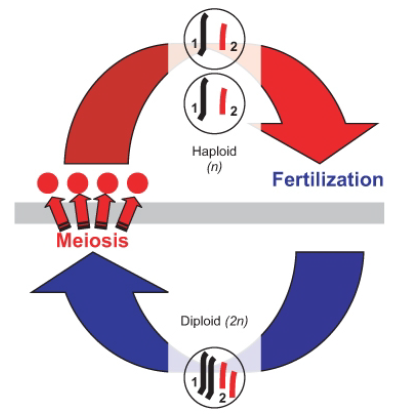
FIGURE 1.3
During meiosis the number of chromosomes is reduced from a
diploid number (2n) to a haploid number (n). During fertilization,
haploid gametes come together to form a diploid zygote and the original
number of chromosomes (2n) is restored. The 8 stages of meiosis are
summarized below. The stages will be described for a human cell,
starting with 46 chromosomes.
Prophase I: Prophase I is the longest phase of meiosis. It is very similar to prophase of mitosis, but with one very significant difference. In Prophase I, the nuclear envelope breaks down, the chromatin condenses into chromosomes, and the centrioles begin to migrate to opposite poles of the cell, with the spindle fibers growing between them. During this time, the homologous chromosomes form pairs. These homologous chromosomes line up gene-for-gene down their entire length tetrads, allowing crossing-over to occur. This process is also called homologous recombination, and is an important step in creating genetic variation.
Prophase I can be further divided into 5 distinct stages: Leptotene, Zygotene, Pachytene, Diplotene and Diakinesis.
Metaphase I: In metaphase I, the 23 pairs of homologous chromosomes line up along the equator or the metaphase plate of the cell. During mitosis, 46 individual chromosomes line up during metaphase, however during meiosis I, the 23 homologous pairs of chromosomes line up. Chromosomes pairs are moved into position by the spindle fibers, which are now attached to the kinetochores at the centromeres. Some chromosomes inherited from the father are facing one side of the cell, and some are facing the other side. This is the basis of independent assortment of chromosomes as described by Gregor Mendel.
Anaphase I: During anaphase I the spindle fibers shorten, and the homologous chromosome pairs are separated from each other. One chromosome from each pair moves toward one pole, with the other moving toward the other pole, resulting in a cell with 23 chromosomes at one pole and the other 23 at the other pole. The sister chromatids remain attached at the centromere. Because human cells have 23 pairs of chromosomes, this independent assortment of chromosomes produces 223, or 8,388,608 possible configurations. More on independent assortment of chromosomes will be presented in the chapter on Mendelian Genetics.
Telophase I: The spindle fiber disassembles and the nucleus reforms. This is quickly followed by cytokinesis and the formation of two haploid cells, each with a unique combination of chromosomes, some from the father and the rest from the mother. After cytokinesis, both cells immediately enter meiosis II; the DNA is not copied in between. Meiosis II is essentially the same as mitosis, separating the sister chromatids from each other.
Prophase II: Once again the nucleus breaks down, and the spindle begins to reform as the centrioles move to opposite sides of the cell.
Metaphase II: The spindle fibers align the 23 chromosomes, each made out of two sister chromatids, along the equator of the cell.
Anaphase II: The sister chromatids are separated and move to opposite poles of the cell. As the chromatids separate, each is known as a chromosome. Anaphase II results in a cell with 23 chromosomes at each end of the cell; each chromosome contains half as much genetic material as at the start of anaphase II.
Telophase II: The nucleus reforms and the spindle fibers break down. Each cell undergoes cytokinesis, producing four haploid cells, each with a unique combination of genes and chromosomes.
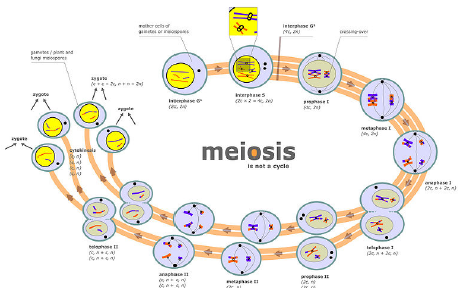
FIGURE 1.4
Meiosis is a process in which a diploid cell divides itself into four haploid cells. c represents the number of chromosomes, n represents a haploid cell, 2n represents a diploid cell.
Meiosis and Genetic Variation
Sexual reproduction results in infinite possibilities of genetic variation. This occurs through a number of mechanisms, including crossing-over, the independent assortment of chromosomes during anaphase I, and random fertilization.
Crossing-over occurs during prophase I. Crossing-over is the exchange of genetic material between non-sister chromatids of homologous chromosomes. Recall during prophase I, homologous chromosomes line up in pairs, gene-for-gene down their entire length, forming a configuration with four chromatids, known as a tetrad. At this point, the chromatids are very close to each other and some material from two chromatids switch chromosomes, that is, the material breaks off and reattaches at the same position on the homologous chromosome ( Figure 1.5). This exchange of genetic material can happen many times within the same pair of homologous chromosomes, creating unique combinations of genes. This process is also known as recombination.
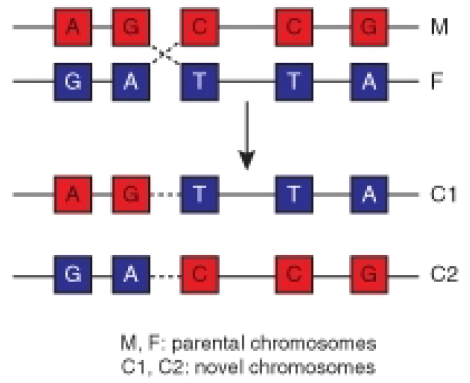
FIGURE 1.5
Crossing-over. A maternal strand of DNA is shown in red. A paternal strand of DNA is shown in blue. Crossing over produces two chromosomes that have not previously existed. The process of recombination involves the breakage and rejoining of parental chromosomes (M, F). This results in the generation of novel chromosomes (C1, C2) that share DNA from both parents.
As mentioned above, in humans there are over 8 million configurations in which the chromosomes can line up during metaphase I. It is the specific processes of meiosis, resulting in four unique haploid cells, that results in these many combinations. Figure 1.6 compares mitosis and meiosis. This independent assortment, in which the chromosome inherited from either the father or mother can sort into any gamete, produces the potential for tremendous genetic variation. Together with random fertilization, more possibilities for genetic variation exist between any two people than individuals alive today. Sexual reproduction is the random fertilization of a gamete from the female using a gamete from the male. In humans, over 8 million (223) chromosome combinations exist in the production of gametes in both the male and female. A sperm cell, with over 8 million chromosome combinations, fertilizes an egg cell, which also has over 8 million chromosome combinations. That is over 64 trillion unique combinations, not counting the unique combinations produced by crossing-over. In other words, each human couple could produce a child with over 64 trillion unique chromosome combinations.
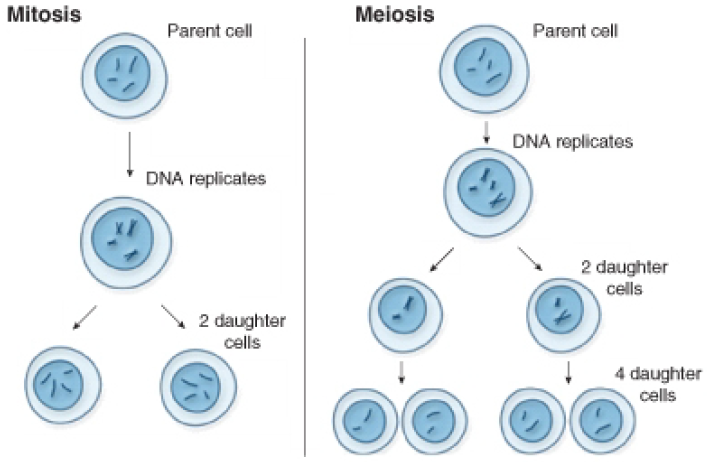
FIGURE 1.6
Mitosis vs. Meiosis Comparison. Mitosis produces two diploid daughter cells, genetically identical to the parent cell. Meiosis produces four haploid daughter cells, each genetically unique.
Gametogenesis
At the end of meiosis, haploid cells are produced. These cells need to further develop into mature gametes capable of fertilization, a process called gametogenesis ( Figure 1.7). Gametogenesis differs between the sexes. In the male, the production of mature sperm cells, or spermatogenesis, results in four haploid gametes, whereas, in the female, the production of a mature egg cell, oogenesis, results in just one mature gamete.
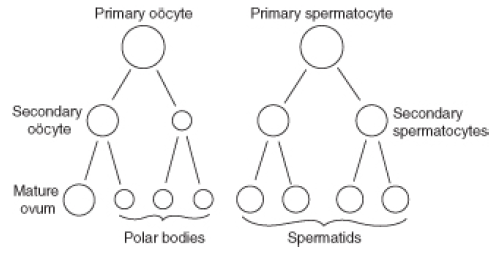
FIGURE 1.7
Analogies in the process of maturation of the ovum and the development of the spermatids. Four haploid spermatids form during meiosis from the primary spermatocyte, whereas only 1 mature ovum, or egg forms during meiosis from the primary oocyte. Three polar bodies may form during oogenesis. These polar bodies will not form mature gametes.
During spermatogenesis, primary spermatocytes go through the first cell division of meiosis to produce secondary spermatocytes. These are haploid cells. Secondary spermatocytes then quickly complete the meiotic division to become spermatids, which are also haploid cells. The four haploid cells produced from meiosis develop a flagellum tail and compact head piece to become mature sperm cells, capable of swimming and fertilizing an egg. The compact head, which has lost most of its cytoplasm, is key in the formation of a streamlined shape. The middle piece of the sperm, connecting the head to the tail, contains many mitochondria, providing energy to the cell. The sperm cell essentially contributes only DNA to the zygote.
On the other hand, the egg provides the other half of the DNA, but also organelles, building blocks for compounds such as proteins and nucleic acids, and other necessary materials. The egg, being much larger than a sperm cell, contains almost all of the cytoplasm a developing embryo will have during its first few days of life. Therefore, oogenesis is a much more complicated process than spermatogenesis.
Oogenesis begins before birth and is not completed until after fertilization. Oogenesis begins when an oogonia (singular, oogonium), which are the immature eggs that form in the ovaries before birth, with the diploid number of chromosomes undergoes mitosis to form primary oocytes, also with the diploid number. It proceeds as a primary oocyte undergoes the first cell division of meiosis to form secondary oocytes with the haploid number of chromosomes. A secondary oocyte undergoes the second meiotic cell division to form a haploid ovum if it is fertilized by a sperm. The one egg cell that results from meiosis contains most of the cytoplasm, nutrients, and organelles. This unequal distribution of materials produces one large cell, and one cell with little more than DNA. This other cell, known as a polar body, eventually breaks down. The larger cell undergoes meiosis II, once again producing a large cell and a polar body. The large cell develops into the mature gamete, called an ovum.
Sexual Life Cycles
Eukaryotes have three different versions of the sexual life cycle: a haploid life cycle, a diploid life cycle, and a life cycle known as the alternation of generations ( Figure 1.8). A life cycle is the span in the life of an organism from one generation to the next. All species that reproduce sexually follow a basic pattern, alternating between haploid and diploid chromosome numbers. The sexual life cycle depends on when meiosis occurs and the type of cell that undergoes meiosis.
Haploid Life Cycles
The haploid life cycle is the simplest life cycle. Organisms with this life cycle, such as many protists and some fungi and algae, spend the majority of their life cycle as a haploid cell. In fact, the zygote is the only diploid cell.

FIGURE 1.8
Sexual Life Cycles.
The zygote immediately undergoes meiosis, producing four haploid cells, which grow into haploid multicellular organisms. These organisms produce gametes by mitosis. The gametes fuse through a process called fusion to produce diploid zygotes which undergo meiosis, continuing the life cycle.
Diploid Life Cycles
Organisms that have a diploid life cycle spend the majority of their lives as diploid adults. All diploid adults inherit half of their DNA from each parent. When they are ready to reproduce, diploid reproductive cells undergo meiosis and produce haploid gametes. These gametes then fuse through fertilization and produce a diploid zygote, which immediately enters G1 of the cell cycle. Next, the zygote’s DNA is replicated. Finally, the processes of mitosis and cytokinesis produce two genetically identical diploid cells. Through repeated rounds of growth and division, this organism becomes a diploid adult and the cycle continues.
Alternation of Generations
Plants, algae, and some protists have a life cycle that alternates between diploid and haploid phases, known as alternation of generations. In plants, the life cycle alternates between the diploid sporophyte and haploid gametophyte. Spore forming cells in the diploid sporophyte undergo meiosis to produce spores, a haploid reproductive cell. Spores can develop into an adult without fusing with another cell. The spores give rise to a multicellular haploid gametophyte, which produce gametes by mitosis. The gametes fuse, producing a diploid zygote, which grow into the diploid sporophyte.
Lesson Summary
• Asexual reproduction produces a clone, an organism that is genetically identical to its parent.
• Asexual reproduction includes fission, fragmentation and budding.
• Sexual reproduction involves haploid gametes and produces a diploid zygote through fertilization.
• Meiosis is a type of cell division that halves the number of chromosomes. There are eight stages of meiosis, divided into meiosis I and meiosis II. DNA is not replicated between meiosis I and meiosis II.
• Crossing-over, the independent assortment of chromosomes during anaphase I, and random fertilization result in genetic variation.
• Meiosis is a step during spermatogenesis and oogenesis. Spermatogenesis produces four haploid sperm cells, while oogenesis produces one mature ovum.
• Eukaryotes have three different versions of the sexual life cycle: a haploid life cycle, a diploid life cycle, and a life cycle known as the alternation of generations. The sexual life cycle depends on when meiosis occurs and the type of cell that undergoes meiosis.
Review Questions
1. Define crossing-over in meiosis.
2. Describe how crossing-over, independent assortment, and random fertilization lead to genetic variation.
3. Compare and contrast mitosis and meiosis.
4. List the main differences between asexual and sexual reproduction.
5. How many chromosomes does a diploid human cell have? How many chromosomes does a haploid human cell have?
6. Name the three different sexual life cycles. What characterizes the differences between these life cycles?
7. Compare binary fission and asexual reproduction.
Vocabulary
alternation of generations: A life cycle that alternates between diploid and haploid phases.
asexual reproduction: Reproduction without gametes; the simplest and most primitive method of reproduction; produces a clone, an organism that is genetically identical to its parent.
budding: Asexual reproduction in which new individuals split off from existing ones; the bud may stay attached or break free from the parent.
crossing-over: The exchange of genetic material between non-sister chromatids of homologous chromosomes; also known as recombination.
diploid: A cell containing two sets of chromosomes; in human cells, two sets contains 46 chromosomes.
fertilization: The joining of gametes during reproduction.
fission: Asexual reproduction in which a parent separates into two or more individuals of about equal size.
fragmentation: Asexual reproduction in which the body breaks into several fragments, which later develop into complete adults.
gametes: An organism’s reproductive cells, such as sperm and egg cells.
gametogenesis: The further maturation of the haploid cells produced by meiosis into mature gametes capable of fertilization.
gametophyte: Produces gametes by mitosis; in alternation of generation life cycles.
haploid: A cell containing one set of chromosomes; in human gametes, one set is 23 chromosomes.
life cycle: The span in the life of an organism from one generation to the next.
meiosis: A type of cell division that halves the number of chromosomes.
oogenesis: The production of a mature egg cell; results in just one mature ovum, or egg cell.
polar body: Cell formed during oogenesis; contains little cytoplasm and eventually breaks down; does not form a gamete.
sexual reproduction: Reproduction involving the joining of haploid gametes, producing genetically diverse individuals.
spermatogenesis: The production of mature sperm cells; results in four haploid gametes.
spore: A haploid reproductive cell; found in plants, algae and some protists; can develop into an adult without fusing with another cell.
tetrad: A configuration with four chromatids; formed by the pairing of homologous chromosomes during prophase I of meiosis.
